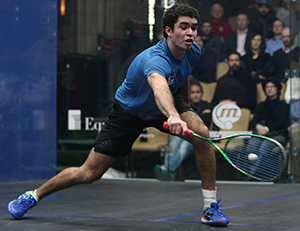|
|

Trends in Stringing: Professional Squash
By Steve Crandall
Vice President, Sales & Marketing
Ashaway Racket Strings

Ashaway Sponsors Diego Elias |
I recently returned from my annual visit to the US Open Squash Championships. I love to watch the competition, but I also like to personally meet with as many players as possible - especially Ashaway sponsored players - and talk about strings and stringing at the professional level. The opportunity to meet with players face to face provides a much more detailed perspective on pro stringing habits, and adds to my frequent "What's App" chats with our players as they tour the world.
This year, I was quite intrigued with what sounded like a new trend. To be sure, I decided to do a closer analysis of the string choices of players on Ashaway's PSA sponsorship roster. We currently have sponsorships with more than 30 players in the top 150 on the Men's and Women's PSA ranking list. Most of these are administered by Ashaway's international distributors in the players' home countries. But players in the top 10 often work directly with Ashaway's USA head office. In addition, many international players contact Ashaway USA for "'one off"' string deliveries when competing in the US. So I had plenty of data to sort.
When I reviewed string usage on the 2017 PSA sponsorship list, it became clear that what I heard from players was indeed the case: there has been a significant increase in the use of string that has some Zyex® incorporated into the construction. When I compared 2017 string selections to 2014 selections, this trend became even more obvious. In 2014, approximately half of Ashaway sponsored players used Zyex-based multifilament strings like PowerNick® and UltraNick®, while the other half selected a multifilament nylon from the SuperNick® XL family. This year, with the addition of two new Zyex-based SuperNick ZX strings, the number of players using a string with Zyex filaments is up to nearly 70%.
Obviously, this increase speaks volumes about the advantages of Zyex as a racquet string material and the many ways it can be utilized.
Currently there are three Zyex combinations that work very well in squash strings. One is a Zyex multifilament core construction used in our UltraNick family of strings. Multifilament construction adds sheer strength to the core and reduces the liveliness of the strings just enough to provide optimum power and control. Both the 17 and 18 gauge versions offer exceptional tension retention and deliver what we call 'soft power.'
Our PowerNick family, on the other hand, generates 'hard power,' that crispness, or popping sensation of the ball leaping off the racquet the instant it strikes. Where UltraNick will stretch a bit before rebounding, PowerNick strings are stiffer and rebound faster, driving the ball. We achieve this by using what we call a multi-stranded Zyex monofilament core. This is a single large monofilament surrounded by a number of slightly thinner monofilaments, all encapsulated in a high-tenacity monofilament nylon wear layer, textured to provide optimum ball response and spin characteristics.
Still, some players like the feel of traditional multifilament nylon. That's why it has been the gold standard in squash strings for so many years. Nylon multifilaments are very responsive, generating good playability. They are inexpensive compared to other synthetics and provide good abrasion resistance. The Ashaway SuperNick ZX family of strings retains these characteristics with a multifilament nylon core, but adds a Zyex fiber wear layer. This combination adds power, improves tension holding, and increases string durability. A textured surface on the wear layer also increases grip and maximizes ball control and spin potential.
In concert with this increased use of Zyex-based strings, my conversations with many pros in Philadelphia highlighted another trend, albeit a more subtle one. Players are stringing at about 10% lower tensions when using Zyex-based string. The better tension holding ability of Zyex, plus the added power and improved durability, encourage this. Multifilament nylon historically required higher tensions due to gradual loosening over time. With Zyex, the tension you string is the tension you keep, no matter how long the match.
As a string manufacturer, it is incredibly important to get the kind of direct feedback from top players I got at the US Open, and I look forward to my next visit with the pros at the Tournament of Champions in New York City in January.
ZYEX® is a registered trademark of Victrex Ltd.
This article previously appeared in Squash Magazine.
|